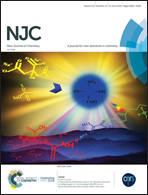Insights into the mechanisms of Ag-catalyzed synthesis of CF3-substituted heterocycles via [3+2]-cycloaddition from α-trifluoromethylated methyl isocyanides: effects of DBU and exploration of diastereoselectivity†
Abstract
A computational study with the B3LYP density functional is carried out to explore the effects of DBU on the Ag-catalyzed synthesis of CF3-substituted heterocycles via [3+2]-cycloaddition with good diastereoselectivity. The calculations suggest that the additive DBU is critical in the reactions because it can help proton-shift via the two-step proton-transfer process as a proton shuttle. In addition, we find that Ag2CO3 also plays a role similar to that of DBU in the reaction. Moreover, the diastereoselectivity of [3+2]-cycloaddition is reasonably explained by the analysis of electronic interaction and steric hindrance on the basis of the theoretical calculations. Our calculations reproduce the experimental results very well. This study is expected to improve the understanding of the transition metal-catalyzed stereoselective reactions involving Lewis base as the additive, and to provide guidance for the future design of novel catalysts and reactions.
![Graphical abstract: Insights into the mechanisms of Ag-catalyzed synthesis of CF3-substituted heterocycles via [3+2]-cycloaddition from α-trifluoromethylated methyl isocyanides: effects of DBU and exploration of diastereoselectivity](/en/Image/Get?imageInfo.ImageType=GA&imageInfo.ImageIdentifier.ManuscriptID=C9NJ01033E&imageInfo.ImageIdentifier.Year=2019)


 Please wait while we load your content...
Please wait while we load your content...